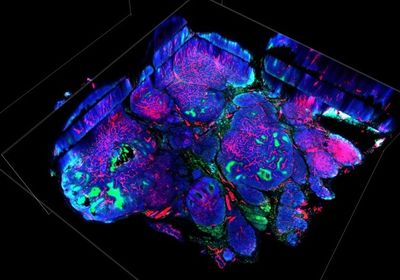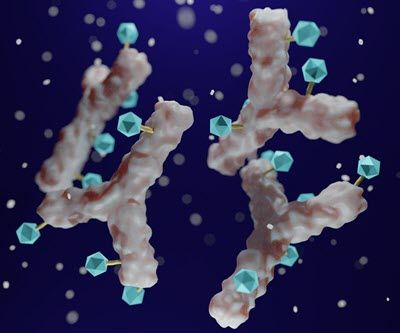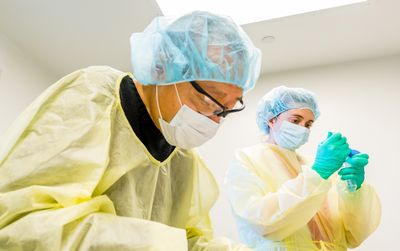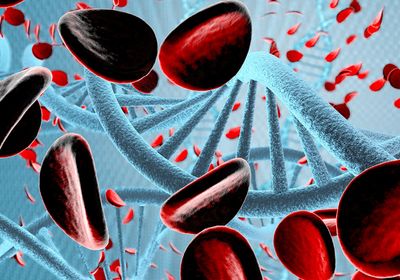ABOVE: Tomography image of tumor in mouse model of HER2-positive breast cancer. Hypoxic areas are in green. Steve Seung-Young Lee | National Cancer Institute | Univ. of Chicago Comprehensive Cancer Center
A self-charging implantable battery that sucks oxygen away from tumors makes some masses more vulnerable to destruction, according to a study published March 31 in Science Advances. When used in tandem with existing drugs, the implantable device shrunk mouse tumors by 90 percent, leading the study authors to suggest it could one day improve localized cancer treatments.
Tumor growth often outpaces the growth of its blood supply, leaving portions of the tumor in a state of oxygen deprivation known as hypoxia. While hypoxia is typically considered harmful to cells, it can paradoxically aid tumors by driving mutations that make the cells resistant to cancer therapies. But it also distinguishes cancerous tissues from nearby healthy ones, so for decades, scientists have attempted to leverage the hypoxic nature of the tumor by targeting tumors with drugs that are activated in low oxygen conditions, called hypoxia-activated prodrugs (HAPs).
Unfortunately, they’ve had little success. Most HAPs have floundered in Phase 3 clinical trials because they failed to prevent tumor growth or caused severe side effects. These shortcomings stem from the fact that tumors are often inadequately or unevenly hypoxic, the authors write in the paper. If there was a way to make the entire tumor hypoxic, the drugs would be more effective, the researchers suggest.
See “Oral Cancer Survives Starvation with Help from Nearby Nerves”
“I think it’s an interesting addition to strategies to enhance the efficacy of hypoxia-activated prodrugs,” says Martin Brown, a cancer biologist and emeritus professor at Stanford who was not involved in the study. “Nobody has come up with the idea of using a self-charging battery to consume oxygen, as far as I know.”
So to lower the oxygen concentration in the tumor microenvironment—and perhaps enhance HAPs’ efficacy—Yongyao Xia and Fan Zhang, both bioengineers at Fudan University in Shanghai, and their colleagues designed an oxygen-slurping battery. The design consists of a small, flat disk coated with zinc on one side and polyimide on the other. When placed in saline, the battery charges itself, performing a powerful redox reaction that devours oxygen.
“When the battery is exhausted in an aqueous environment, the oxygen in the aqueous environment can be served as “power” to charge the battery, thus achieving a reversible cycle of charge and discharge process and continuous oxygen consumption,” the study authors write in an email to The Scientist.
To test how well this battery could combat tumors, the researchers implanted mice with 4T1 cells, highly invasive tumor-forming cells that model human breast cancer. After seven days, all the mice had developed tumors. So, on the seventh day, researchers implanted batteries around the tumors of some of the mice. The day after, a subset of mice received the cancer drug tirapazamine (TPZ), in hopes that the battery would enhance its efficacy.
The scientists analyzed the tumors two weeks after battery implantation, finding that the battery alone shrunk tumors by 26 percent. In addition, tumors largely disappeared in mice who received both battery implantation and TPZ: The average tumor volume decreased by 90 percent. After the experiment, the researchers also fluorescently labeled proteins in the tumor that are expressed in hypoxic conditions, finding that the battery managed to induce hypoxia throughout the tumor.
Brown points out that while the approach was innovative, mouse tumors are smaller than human tumors, and he’s unsure if such an approach would be easy to translate to the clinic or whether the battery would be able to induce hypoxia throughout larger tumors. “The issue with a bigger tumor,” he says, is that the battery can only suck up oxygen nearby. “Everything depends on the extent of oxygen depletion from the battery surface,” Brown says.
Xiao and Zhang acknowledge that since human tumors are larger, they may require more powerful batteries. Still, they say they hope that the batteries will be able to “offer highly targeted, more effective and creative strategies against tumors.”







